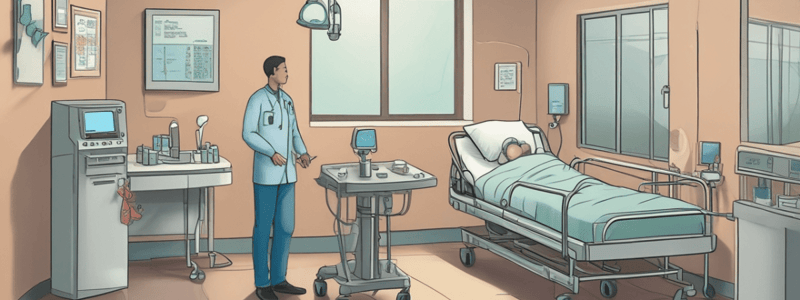Podcast
Questions and Answers
What is the primary role of morphine in the treatment protocol described?
What is the primary role of morphine in the treatment protocol described?
- To improve cardiac output through increased heart rate
- To decrease stress and anxiety while improving venous return (correct)
- To provide high-flow oxygen to the patient
- To enhance the effectiveness of blood transfusions
Why is Ringer's solution preferred over normal saline for massive hemorrhage treatment?
Why is Ringer's solution preferred over normal saline for massive hemorrhage treatment?
- It contains a higher concentration of glucose for energy
- It is easier to administer than normal saline
- It provides better electrolyte balance during fluid resuscitation (correct)
- It has a higher potassium content suitable for cell recovery
What is the recommended systolic blood pressure threshold to maintain in hemodynamic support?
What is the recommended systolic blood pressure threshold to maintain in hemodynamic support?
- Exactly 100 mmHg
- Above 120 mmHg
- Below 80 mmHg
- Above 100 mmHg (correct)
Which of the following conditions is NOT listed as a cause of cardiogenic shock?
Which of the following conditions is NOT listed as a cause of cardiogenic shock?
Which medication is specifically mentioned for controlling ventricular arrhythmias?
Which medication is specifically mentioned for controlling ventricular arrhythmias?
What is the function of nitroglycerin in the treatment approach stated?
What is the function of nitroglycerin in the treatment approach stated?
What is the usual dosage range for dobutamine administration in the treatment protocol?
What is the usual dosage range for dobutamine administration in the treatment protocol?
Which of the following treatments is considered to decrease pulmonary congestion most effectively?
Which of the following treatments is considered to decrease pulmonary congestion most effectively?
Furosemide has no impact on venous return and pulmonary congestion.
Furosemide has no impact on venous return and pulmonary congestion.
Acute myocardial infarction is one of the causes of cardiogenic shock.
Acute myocardial infarction is one of the causes of cardiogenic shock.
High-flow oxygen is used to exacerbate pulmonary vascular congestion.
High-flow oxygen is used to exacerbate pulmonary vascular congestion.
Dopamine is administered to decrease cardiac output in treatment protocols.
Dopamine is administered to decrease cardiac output in treatment protocols.
Ringer's solution is inferior to normal saline for use in massive hemorrhage.
Ringer's solution is inferior to normal saline for use in massive hemorrhage.
Morphine is utilized primarily for pain management in severe pulmonary congestion.
Morphine is utilized primarily for pain management in severe pulmonary congestion.
Dobutamine is typically administered in doses between 10 - 40 μg/kg/min.
Dobutamine is typically administered in doses between 10 - 40 μg/kg/min.
The primary treatment for ventricular arrhythmia is sodium bicarbonate administration.
The primary treatment for ventricular arrhythmia is sodium bicarbonate administration.
What role does furosemide play in the management of pulmonary congestion?
What role does furosemide play in the management of pulmonary congestion?
What effect does morphine have on the work of breathing in patients with pulmonary congestion?
What effect does morphine have on the work of breathing in patients with pulmonary congestion?
How does high-flow oxygen contribute to changes in cardiac load?
How does high-flow oxygen contribute to changes in cardiac load?
What is the main purpose of administering dopamine in the treatment of cardiogenic shock?
What is the main purpose of administering dopamine in the treatment of cardiogenic shock?
Describe the significance of maintaining a systolic blood pressure greater than 100 mmHg in treatment protocols.
Describe the significance of maintaining a systolic blood pressure greater than 100 mmHg in treatment protocols.
What are some causes of cardiogenic shock listed in the content?
What are some causes of cardiogenic shock listed in the content?
In what context is Lidocaine administered intravenously during treatment?
In what context is Lidocaine administered intravenously during treatment?
Why is Ringer's solution considered superior to normal saline during massive hemorrhage treatment?
Why is Ringer's solution considered superior to normal saline during massive hemorrhage treatment?
High-flow ______ is used to address hypoxia caused by pulmonary vascular congestion.
High-flow ______ is used to address hypoxia caused by pulmonary vascular congestion.
Furosemide is administered to decrease venous ______ and pulmonary congestion.
Furosemide is administered to decrease venous ______ and pulmonary congestion.
Morphine decreases stress and anxiety, which in turn reduces work of ______.
Morphine decreases stress and anxiety, which in turn reduces work of ______.
The recommended dosage for dobutamine is usually between ______ μg/kg/min.
The recommended dosage for dobutamine is usually between ______ μg/kg/min.
One of the causes of cardiogenic shock is acute ______.
One of the causes of cardiogenic shock is acute ______.
Ringer's solution is considered more ______ than normal saline for massive hemorrhage.
Ringer's solution is considered more ______ than normal saline for massive hemorrhage.
Blood ______ is a common treatment in cases of massive hemorrhage.
Blood ______ is a common treatment in cases of massive hemorrhage.
Nitroglycerin can be administered sublingually or via ______.
Nitroglycerin can be administered sublingually or via ______.
Match the following medications with their specific roles in treating pulmonary congestion and cardiogenic shock:
Match the following medications with their specific roles in treating pulmonary congestion and cardiogenic shock:
Match the following causes of cardiogenic shock with their descriptions:
Match the following causes of cardiogenic shock with their descriptions:
Match the following treatments with their indications:
Match the following treatments with their indications:
Match the following therapeutic strategies with their effects:
Match the following therapeutic strategies with their effects:
Match the following patient management strategies with their relevant outcomes:
Match the following patient management strategies with their relevant outcomes:
Match the following drugs with their administration routes:
Match the following drugs with their administration routes:
Match the following physiological effects with their related interventions:
Match the following physiological effects with their related interventions:
Match the following terms related to management of acute conditions with their definitions:
Match the following terms related to management of acute conditions with their definitions:
Flashcards are hidden until you start studying
Study Notes
Management of Hospitalization
- Positioning is critical: hospital patients often placed in sitting or semi-sitting positions to improve respiratory function.
- High-flow oxygen is administered to treat hypoxia, which can cause pulmonary vasoconstriction and increase cardiac workload.
Key Treatments
-
Furosemide (20-80 mg IV):
- Reduces venous return and alleviates pulmonary congestion.
- Considered the most important treatment for managing fluid overload.
-
Morphine (2-4 mg IV):
- Alleviates stress and anxiety in patients.
- Acts as a venodilator, decreasing venous return and lung congestion.
- Reduces pulmonary stretch reflex, thereby decreasing tachypnea and respiratory effort.
-
Nitroglycerin:
- Administered sublingually or intravenously for rapid effect against chest pain and heart strain.
-
Hemodynamic Support:
- Aim to maintain systolic blood pressure (SBP) above 100 mmHg.
- Monitoring and adjusting treatment based on SBP response.
Treatment for Hemodynamic Emergency
-
I.V. Fluids:
- Ringer's solution preferred over normal saline for massive hemorrhage scenarios.
-
Blood Transfusion:
- Critical in cases of significant blood loss to restore hemoglobin levels.
-
Dopamine:
- Used to increase cardiac output (COP) in patients experiencing shock.
Causes of Cardiogenic Shock
- Acute Myocardial Infarction (MI): Major contributing factor.
- Blunt Cardiac Trauma: Injury affecting cardiac function.
- Myocardial Depression: Can be induced by drugs or infections affecting heart contractility.
Treatments for Cardiogenic Shock
- Comprehensive approach includes all treatment protocols for acute MI.
- Dobutamine IV: Typically administered at 5-20 µg/kg/min to enhance cardiac output.
- Lidocaine IV: Utilized to manage and control ventricular arrhythmias during shock states.
Management of Hospitalization
- Positioning is critical: hospital patients often placed in sitting or semi-sitting positions to improve respiratory function.
- High-flow oxygen is administered to treat hypoxia, which can cause pulmonary vasoconstriction and increase cardiac workload.
Key Treatments
-
Furosemide (20-80 mg IV):
- Reduces venous return and alleviates pulmonary congestion.
- Considered the most important treatment for managing fluid overload.
-
Morphine (2-4 mg IV):
- Alleviates stress and anxiety in patients.
- Acts as a venodilator, decreasing venous return and lung congestion.
- Reduces pulmonary stretch reflex, thereby decreasing tachypnea and respiratory effort.
-
Nitroglycerin:
- Administered sublingually or intravenously for rapid effect against chest pain and heart strain.
-
Hemodynamic Support:
- Aim to maintain systolic blood pressure (SBP) above 100 mmHg.
- Monitoring and adjusting treatment based on SBP response.
Treatment for Hemodynamic Emergency
-
I.V. Fluids:
- Ringer's solution preferred over normal saline for massive hemorrhage scenarios.
-
Blood Transfusion:
- Critical in cases of significant blood loss to restore hemoglobin levels.
-
Dopamine:
- Used to increase cardiac output (COP) in patients experiencing shock.
Causes of Cardiogenic Shock
- Acute Myocardial Infarction (MI): Major contributing factor.
- Blunt Cardiac Trauma: Injury affecting cardiac function.
- Myocardial Depression: Can be induced by drugs or infections affecting heart contractility.
Treatments for Cardiogenic Shock
- Comprehensive approach includes all treatment protocols for acute MI.
- Dobutamine IV: Typically administered at 5-20 µg/kg/min to enhance cardiac output.
- Lidocaine IV: Utilized to manage and control ventricular arrhythmias during shock states.
Management of Hospitalization
- Positioning is critical: hospital patients often placed in sitting or semi-sitting positions to improve respiratory function.
- High-flow oxygen is administered to treat hypoxia, which can cause pulmonary vasoconstriction and increase cardiac workload.
Key Treatments
-
Furosemide (20-80 mg IV):
- Reduces venous return and alleviates pulmonary congestion.
- Considered the most important treatment for managing fluid overload.
-
Morphine (2-4 mg IV):
- Alleviates stress and anxiety in patients.
- Acts as a venodilator, decreasing venous return and lung congestion.
- Reduces pulmonary stretch reflex, thereby decreasing tachypnea and respiratory effort.
-
Nitroglycerin:
- Administered sublingually or intravenously for rapid effect against chest pain and heart strain.
-
Hemodynamic Support:
- Aim to maintain systolic blood pressure (SBP) above 100 mmHg.
- Monitoring and adjusting treatment based on SBP response.
Treatment for Hemodynamic Emergency
-
I.V. Fluids:
- Ringer's solution preferred over normal saline for massive hemorrhage scenarios.
-
Blood Transfusion:
- Critical in cases of significant blood loss to restore hemoglobin levels.
-
Dopamine:
- Used to increase cardiac output (COP) in patients experiencing shock.
Causes of Cardiogenic Shock
- Acute Myocardial Infarction (MI): Major contributing factor.
- Blunt Cardiac Trauma: Injury affecting cardiac function.
- Myocardial Depression: Can be induced by drugs or infections affecting heart contractility.
Treatments for Cardiogenic Shock
- Comprehensive approach includes all treatment protocols for acute MI.
- Dobutamine IV: Typically administered at 5-20 µg/kg/min to enhance cardiac output.
- Lidocaine IV: Utilized to manage and control ventricular arrhythmias during shock states.
Management of Hospitalization
- Positioning is critical: hospital patients often placed in sitting or semi-sitting positions to improve respiratory function.
- High-flow oxygen is administered to treat hypoxia, which can cause pulmonary vasoconstriction and increase cardiac workload.
Key Treatments
-
Furosemide (20-80 mg IV):
- Reduces venous return and alleviates pulmonary congestion.
- Considered the most important treatment for managing fluid overload.
-
Morphine (2-4 mg IV):
- Alleviates stress and anxiety in patients.
- Acts as a venodilator, decreasing venous return and lung congestion.
- Reduces pulmonary stretch reflex, thereby decreasing tachypnea and respiratory effort.
-
Nitroglycerin:
- Administered sublingually or intravenously for rapid effect against chest pain and heart strain.
-
Hemodynamic Support:
- Aim to maintain systolic blood pressure (SBP) above 100 mmHg.
- Monitoring and adjusting treatment based on SBP response.
Treatment for Hemodynamic Emergency
-
I.V. Fluids:
- Ringer's solution preferred over normal saline for massive hemorrhage scenarios.
-
Blood Transfusion:
- Critical in cases of significant blood loss to restore hemoglobin levels.
-
Dopamine:
- Used to increase cardiac output (COP) in patients experiencing shock.
Causes of Cardiogenic Shock
- Acute Myocardial Infarction (MI): Major contributing factor.
- Blunt Cardiac Trauma: Injury affecting cardiac function.
- Myocardial Depression: Can be induced by drugs or infections affecting heart contractility.
Treatments for Cardiogenic Shock
- Comprehensive approach includes all treatment protocols for acute MI.
- Dobutamine IV: Typically administered at 5-20 µg/kg/min to enhance cardiac output.
- Lidocaine IV: Utilized to manage and control ventricular arrhythmias during shock states.
Management of Hospitalization
- Positioning is critical: hospital patients often placed in sitting or semi-sitting positions to improve respiratory function.
- High-flow oxygen is administered to treat hypoxia, which can cause pulmonary vasoconstriction and increase cardiac workload.
Key Treatments
-
Furosemide (20-80 mg IV):
- Reduces venous return and alleviates pulmonary congestion.
- Considered the most important treatment for managing fluid overload.
-
Morphine (2-4 mg IV):
- Alleviates stress and anxiety in patients.
- Acts as a venodilator, decreasing venous return and lung congestion.
- Reduces pulmonary stretch reflex, thereby decreasing tachypnea and respiratory effort.
-
Nitroglycerin:
- Administered sublingually or intravenously for rapid effect against chest pain and heart strain.
-
Hemodynamic Support:
- Aim to maintain systolic blood pressure (SBP) above 100 mmHg.
- Monitoring and adjusting treatment based on SBP response.
Treatment for Hemodynamic Emergency
-
I.V. Fluids:
- Ringer's solution preferred over normal saline for massive hemorrhage scenarios.
-
Blood Transfusion:
- Critical in cases of significant blood loss to restore hemoglobin levels.
-
Dopamine:
- Used to increase cardiac output (COP) in patients experiencing shock.
Causes of Cardiogenic Shock
- Acute Myocardial Infarction (MI): Major contributing factor.
- Blunt Cardiac Trauma: Injury affecting cardiac function.
- Myocardial Depression: Can be induced by drugs or infections affecting heart contractility.
Treatments for Cardiogenic Shock
- Comprehensive approach includes all treatment protocols for acute MI.
- Dobutamine IV: Typically administered at 5-20 µg/kg/min to enhance cardiac output.
- Lidocaine IV: Utilized to manage and control ventricular arrhythmias during shock states.
Studying That Suits You
Use AI to generate personalized quizzes and flashcards to suit your learning preferences.





